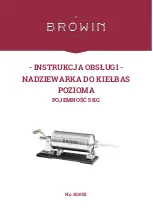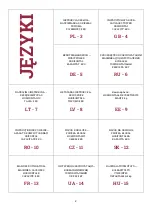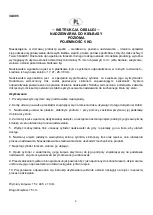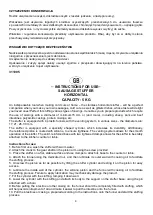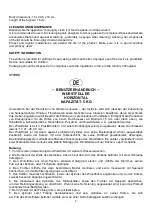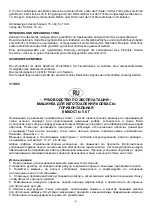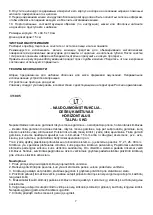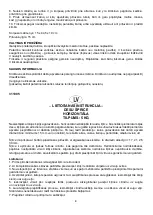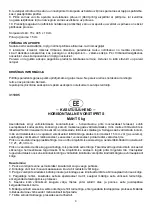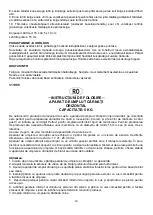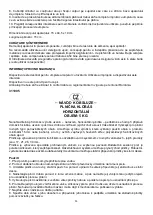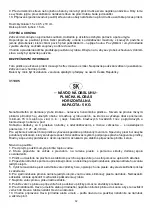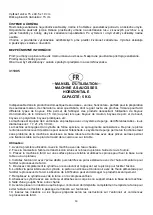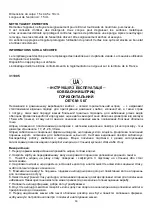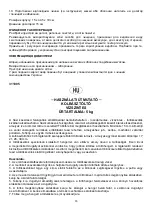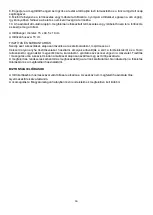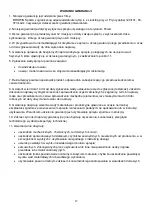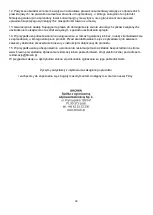
4
CZYSZCZENIE I KONSERWACJA
Rozłóż urządzenie na części, dokładnie oczyść z resztek jedzenia, a następnie umyj.
Wskazane jest używanie łagodnych środków czyszczących przeznaczonych do usuwania tłuszczu
z powierzchni metalowych oraz delikatnych akcesoriów, chroniących przed zarysowaniem – najlepiej gąbki.
Po wycz
yszczeniu / umyciu wszystkie elementy zestawu dokładnie wysusz i wytrzyj do sucha.
Właściwa i regularna konserwacja przedłuży użytkowanie produktu. Dbaj, aby był on w dobrym stanie
przechowywany i właściwie wykorzystywany.
WSKAZÓWKI DOTYCZĄCE BEZPIECZEŃSTWA
Nadziewarka przeznaczona jest do nadziewania osłonek wędliniarskich masą mięsną. Używanie urządzenia
niezgodnie z przeznaczeniem jest zabronione.
Urządzenie nie nadaje się do zabawy dla dzieci.
Opakowanie i zużyty sprzęt należy usunąć zgodnie z przepisami obowiązującymi na terenie państwa,
w którym urządzenie to jest użytkowane.
311005
─ INSTRUCTIONS FOR USE─
SAUSAGE STUFFER
HORIZONTAL
CAPACITY: 5 KG
An indispensable tool when making cold cuts at home
– the stainless horizontal stuffer – will be a perfect
companion when you make your own sausages, cold cuts, as well as giblets dishes, whose taste will delight
your loved ones! Perfect for stuffing various types of casings. It enables you to prepare products which require
the use of casings with a diameter of minimum15 mm or (and more), including sheep, pork and beef
intestines, polyamide casings, protein casings, etc.
The stuffer is equipped with 4 plastic funnels with the venting system, in various sizes - the diameters are:
17, 21, 26, 30 mm.
The stuffer is equipped with a specially shaped cylinder, which increases its durability. Additionally,
the reinforced piston is coated with silicone, to ensure tightness. The venting system allows for the smooth
operation of the stuffer. The solid, reinforced base with two tightened clamps allows for the stuffer to be stably
attached to the kitchen counter or table.
Instructions for use:
1. Before first use, wash the stuffer with warm water.
2. Attach the crank to the gear shaft on the piston arm using the screw provided.
3. Place the stuffer on a flat, stable surface and use clamps to attach its base to the counter or table.
4. Attach the funnel using the dedicated nut, and then lubricate its outer wall with cooking oil to facilitate
the stuffing process.
5. Unscrew the piston as far as possible by lifting the stuffer cylinder and resting it on the piston for easy
access.
6. Lubricate the inside wall of the cylinder, the silicone piston and the funnel with cooking oil to facilitate
the stuffing process. Failure to apply lubrication may mechanically damage the product.
7. Fill the cylinder with the stuffing, tamping it down well.
8. Lower the cylinder with the stuffing and attach its body to the support on the stuffer base, using the pin
attached with a chain.
9. Before putting the intestine or other casing on, the funnel should be completely filled with stuffing, which
will help avoid entrapment of air and make it easier to pull the intestine onto the funnel.
10. Pull the intestines or casings, prepared according to the instructions, onto the funnel and start the stuffing
process.

